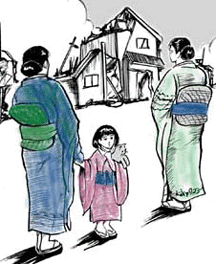Written by students of FC1750.06
at Founders College, York University
Vol.2, no. 3, June-August, 1997
 After its surrender in 1945, Japan was occupied by Allied forces, chiefly the United States,
that changed its military, political, and educational systems (Coillier's Encyclopedia, 1981,
484). A Pale View of Hills, by Kazuo Ishiguro, demonstrates the struggle of
Japan's prewar generation to keep their Japanese identity, values, and traditions, as well as
the responses of the Nagasaki survivors to Western influences.
After its surrender in 1945, Japan was occupied by Allied forces, chiefly the United States,
that changed its military, political, and educational systems (Coillier's Encyclopedia, 1981,
484). A Pale View of Hills, by Kazuo Ishiguro, demonstrates the struggle of
Japan's prewar generation to keep their Japanese identity, values, and traditions, as well as
the responses of the Nagasaki survivors to Western influences.
The first task of the American occupation was demilitarization. Once Japan was demilitarized, many of its leaders were tried and punished while those who had supported militarism and nationalism were declared ineligible for political office in the future (The World Book Encyclopeia 1986, 42). The occupational forces introduced into the school system democratic concepts and practices, replacing the curriculum of the 1890s, which stressed loyalty, filial piety, and emperor worship.
Such postwar realities alarm ogata-san, the retired teacher in A Pale View of Hills. "I devcoted my life to the teaching of the young," he says. "And then I watched the Americans tear it all down" (Ishiguro 1982, 66). His student, Shigeo Matsuda, holds a totally different opinion: "in your day, children in Japan were taught . . .not to see, not to question. And that's why the country was plunged into the most evil disaster in her entire history" (Ishiguro 1982, 147). Meanwhile Japan's new constitution guarantees women equal rights in all fields (The World Book Encyclopedia 1986, 38). As a result, young Japanese women began to move away from the traiditonal role as an obedient wife while the elderly Japanese men have had difficulty accepting the idea of equality between the sexes. "All in the name of democracy people abandon obligations," Ogata-san says, complaining that "A wife feels no sense of loyalty towards the household."
The Japanese place great value upon the family unit, and it has long been a part of the tradition for a couple to live with the husband's family and for the wife to care for her in- laws. Instead, Etsuko and Jiro in A Pale View of Hills live on their own, apart from all in-laws. Etsuko's second daughter, Nikki, goes a step further. Raised in England, she has become like many women in the first world, who fiercely guard their independence. "So many women just get brainwashed," she says. "They think all there is to life is getting married and having a load of kids" (Ishiguro 1982, 179-180). The Japanese emulate the West for they see it as a better place to live. Etsuko moves to England from a country in ruins to escape Japanese customs and restrictions. Her friend, Sachiko, does the same, expecting a drunk named Frank to take her to America. In addition, she wants better opportunities for her daughter, Mariko, who could become an artist, painter, or business girl.
To the Japanese, Western life has much more appeal than their way of life in Asia; therefore, so many have moved to countries like America. Yet a life in a land of opportunities and wealth does not necessarily guarantee happiness. Although it was the Allied forces which reform Japan after World War II, the Japanese are the ones who welcomed and accepted such Western ideas. The postwar generation is slowing beginning to realize that the old Japanese traditions are a part of their identity. A Pale View of Hills ends with Etsuko recognizing that "It's not a bad thing at all, the Japanese way" (Ishiguro, 1982, 181).
Bibliography
Ishiguro, Kazuo. A Pale View of Hills. London: Faber and Faber, 1982.
Illustration by Billy Lo